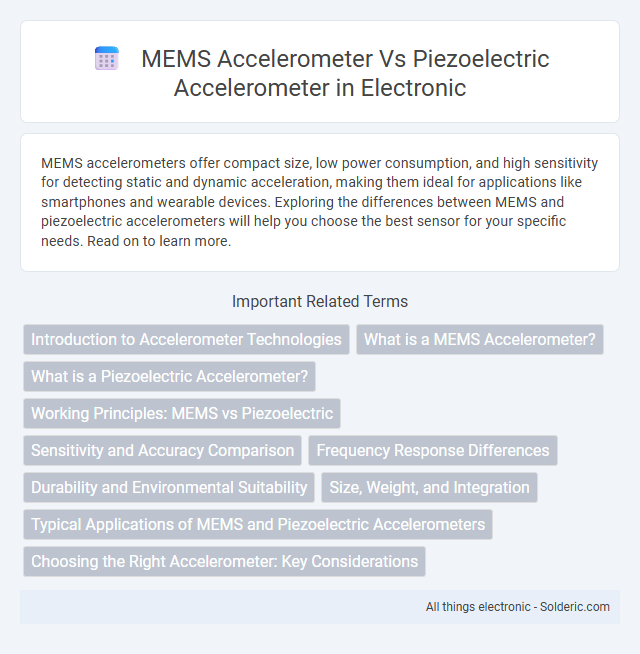MEMS accelerometers offer compact size, low power consumption, and high sensitivity for detecting static and dynamic acceleration, making them ideal for applications like smartphones and wearable devices. Exploring the differences between MEMS and piezoelectric accelerometers will help you choose the best sensor for your specific needs. Read on to learn more.
Comparison Table
| Aspect | MEMS Accelerometer | Piezoelectric Accelerometer |
|---|---|---|
| Operating Principle | Micro-electromechanical system detecting capacitance changes | Generates voltage from piezoelectric crystal deformation |
| Measurement Range | Low to Moderate (+-2g to +-200g) | Moderate to High (up to several thousand g's) |
| Frequency Response | DC to ~5 kHz | High frequency, typically up to 50 kHz or more |
| Output Type | Analog or Digital (often digital) | Analog voltage signal |
| Size & Weight | Small, lightweight, compact | Generally larger and heavier |
| Power Consumption | Low power consumption | Consumes more power due to signal conditioning |
| Sensitivity to Low Frequencies | High sensitivity including DC and static acceleration | Limited, not suitable for static or low-frequency measurements |
| Applications | Consumer electronics, automotive, motion sensing | Industrial vibration monitoring, impact testing |
| Cost | Generally low cost, mass-produced | Higher cost, specialized applications |
Introduction to Accelerometer Technologies
MEMS accelerometers use microelectromechanical systems to detect acceleration through changes in capacitance, offering compact size, low power consumption, and high sensitivity ideal for consumer electronics and automotive applications. Piezoelectric accelerometers generate electrical charge from mechanical stress on piezoelectric materials, providing excellent frequency response and durability suited for industrial vibration and shock measurements. Your choice depends on application-specific requirements such as dynamic range, frequency bandwidth, and environmental conditions.
What is a MEMS Accelerometer?
A MEMS accelerometer is a microelectromechanical system device that measures acceleration forces by detecting changes in capacitance caused by the movement of a tiny mass suspended on micro-scale springs. Unlike piezoelectric accelerometers, which generate voltage from crystal deformation, MEMS accelerometers convert mechanical motion into electrical signals through integrated microstructures, offering compact size, low power consumption, and high sensitivity. Your choice of a MEMS accelerometer is ideal for applications requiring precise, real-time motion detection in compact electronic devices.
What is a Piezoelectric Accelerometer?
A piezoelectric accelerometer is a sensor that measures acceleration by converting mechanical stress into an electrical charge using piezoelectric materials such as quartz or ceramics. Unlike MEMS accelerometers, which rely on microelectromechanical systems to detect motion through changes in capacitance, piezoelectric accelerometers excel in high-frequency vibration measurement and dynamic performance. Your choice depends on application needs, with piezoelectric sensors preferred for precise, high-sensitivity acceleration detection in industrial and aerospace equipment.
Working Principles: MEMS vs Piezoelectric
MEMS accelerometers operate using microelectromechanical systems technology that detects acceleration through capacitive sensing by measuring changes in capacitance caused by the displacement of a suspended proof mass. In contrast, piezoelectric accelerometers generate electrical charge in response to mechanical stress on a piezoelectric crystal when subjected to acceleration forces. MEMS devices excel in low-frequency and static acceleration measurements, while piezoelectric accelerometers are preferred for dynamic and high-frequency vibration detection due to their inherent material properties.
Sensitivity and Accuracy Comparison
MEMS accelerometers offer high sensitivity at low frequencies due to their capacitive sensing mechanism, making them ideal for detecting subtle movements with good accuracy in consumer electronics. Piezoelectric accelerometers excel in high-frequency vibration detection with superior accuracy and dynamic range, suitable for industrial and aerospace applications. Sensitivity in MEMS devices may degrade at high frequencies, whereas piezoelectric sensors maintain consistent performance across a wider frequency spectrum.
Frequency Response Differences
MEMS accelerometers offer a wide frequency response typically ranging from DC to a few kHz, ideal for detecting low-frequency vibrations and static acceleration like gravity. Piezoelectric accelerometers excel in higher frequency response, often up to hundreds of kHz, making them suitable for dynamic measurements and high-frequency vibration analysis. The inherent sensing mechanisms dictate these differences: MEMS capacitive sensing enables low-frequency stability while piezoelectric crystals generate charge only under dynamic acceleration, limiting low-frequency detection.
Durability and Environmental Suitability
MEMS accelerometers offer superior durability with robust silicon construction that withstands shock, vibration, and harsh environments better than piezoelectric accelerometers. Their resistance to temperature variations and ability to operate under extreme environmental conditions make MEMS devices ideal for automotive, industrial, and consumer electronics applications. Piezoelectric accelerometers, while sensitive and accurate for dynamic measurements, generally have limitations in longevity and performance stability in corrosive or high-moisture environments.
Size, Weight, and Integration
MEMS accelerometers offer a significantly smaller size and lighter weight compared to piezoelectric accelerometers, making them ideal for compact and portable applications. Their microfabrication process enables seamless integration with integrated circuits, enhancing sensor fusion and system miniaturization. Your choice should consider that MEMS devices excel in low-frequency and DC acceleration measurements, while piezoelectric sensors typically handle high-frequency vibrations with higher sensitivity.
Typical Applications of MEMS and Piezoelectric Accelerometers
MEMS accelerometers are widely used in consumer electronics, automotive airbag systems, and wearable devices due to their compact size, low power consumption, and ability to measure low-frequency vibrations and static acceleration. Piezoelectric accelerometers excel in industrial machinery monitoring, aerospace, and structural health applications where high-frequency vibration detection and dynamic response are critical. MEMS sensors dominate applications requiring cost-effective, integrated solutions, while piezoelectric sensors are preferred for high-precision, high-frequency vibration analysis.
Choosing the Right Accelerometer: Key Considerations
Selecting the right accelerometer involves evaluating factors such as sensitivity, frequency response, and environmental conditions. MEMS accelerometers offer compact size, low power consumption, and excellent performance for low-frequency applications, while piezoelectric accelerometers provide superior accuracy and stability in high-frequency and high-temperature environments. Understanding application-specific requirements like vibration range, measurement precision, and durability is essential to optimize sensor selection.
MEMS accelerometer vs piezoelectric accelerometer Infographic

 solderic.com
solderic.com